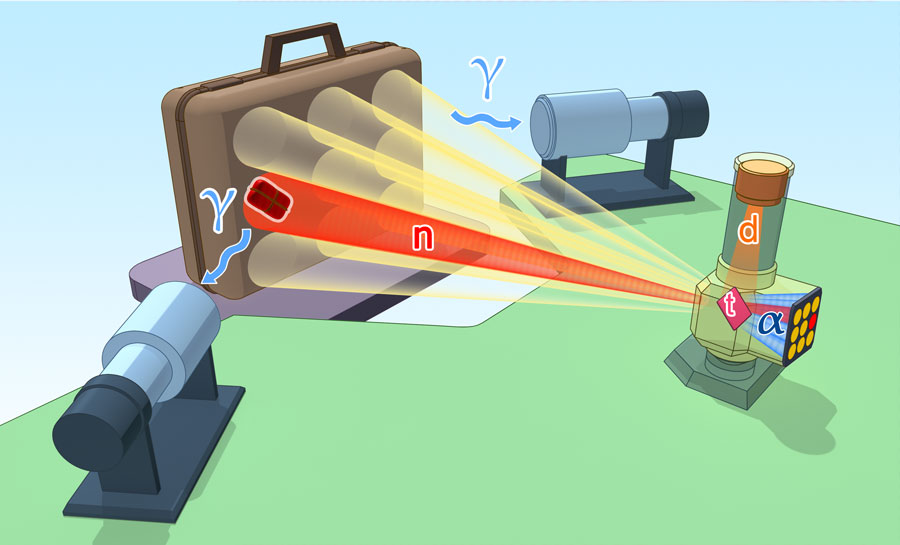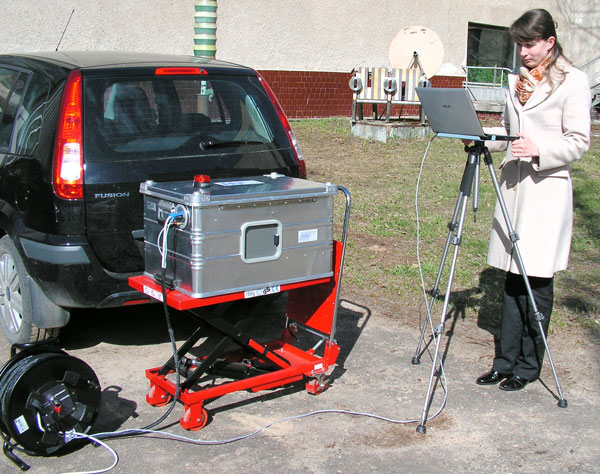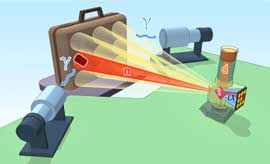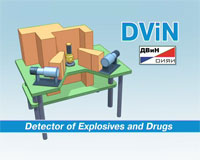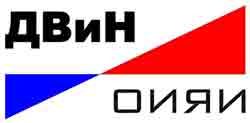Haven't you ever asked yourself a simple question: why is it prohibited to bring any liquids into the plane? The modern X-ray scanners in the airports discern tiniest object in the luggage, don’t they?
The matter is that the X-ray is a kind of hard electromagnetic radiation. And, as we remember from school classes, it is only sensitive to the substance charge Z and its density. Therefore, the X-ray machines, in principle, can distinguish substances with different Z, but they surely fail to provide any information about their elemental composition, i.e. the content of oxygen, carbon or other elements. They discern slightest density contrasts perfectly well. They have no troubles in finding a gun, knife or other dangerous things. They can easily detect a bottle in a passenger’s luggage but they will never find out what is in the bottle.
The elemental composition of the substance may be discovered by irradiating the object with fast neutrons of enough energy. Such neutrons excite the nucleuses of the substance; the excitement is relieved with hard gamma-ray quantum emission.
Consequently, being subject to the fast neutrons, the inspected objects "shines", i.e. emits gamma-ray quanta of 1-10 MeV energies. This "shining" is individual for every element and it is the gamma-ray quantum spectrum that makes it possible to detect the portion of a specific element in the substance.
Figure 1 shows an example of the gamma-ray quantum spectrum for TNT (trotyl) and cyclonite.
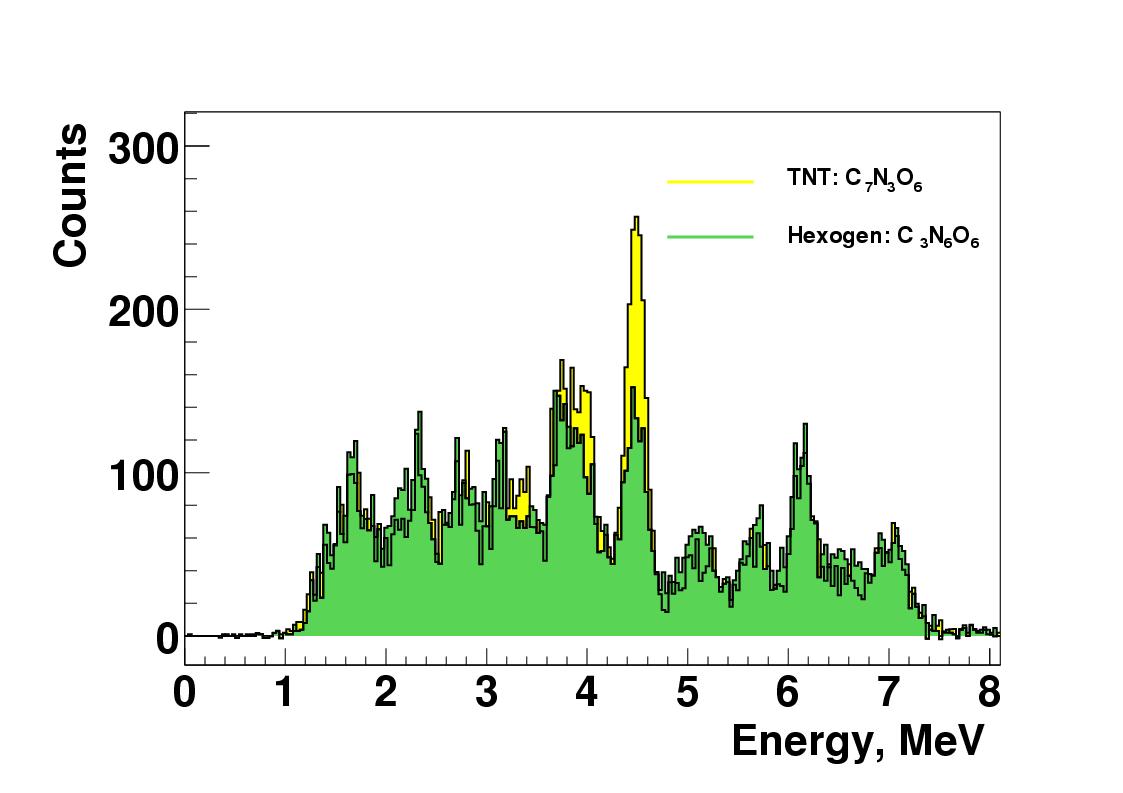
Fig.1 Energy spectra of gamma-ray quanta for TNT (yellow histogram) and cyclonite (green histogram).
We see that the energy spectrum consists of separate lines. The high peak with the energy of 4.43 MeV corresponds with carbon. The elemental composition of TNT (С7 N3 O6) includes more carbon than cyclonite (С3 N6 O6) does. Therefore, the carbon peak of TNT (the yellow histogram) is much greater than that of cyclonite.
The identification of the explosives, drugs and other hazardous substances is based on the fact that the elemental composition of the hazardous substances differs from that of the regular substances. It is shown in Fig.2 that presents the shares of hydrogen, nitrogen and carbon in the regular substances, as well as in the drugs and explosives.
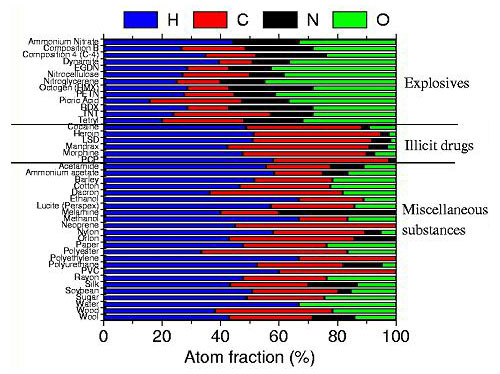
Fig.2 Shares of hydrogen H, oxygen O, and carbon C in regular substances (lower part of the table), in drugs (middle part), and in explosives (upper part).
The source of neutrons for the tagged neutron method (TNM) is the portable deuteron accelerator that provides the deuterons with about 100 keV energy. The deuterons hit the tritium target and produce neutrons of 14 MeV as per the reaction d+t→α+n. This reaction is special as the alpha particle (helium nucleus) and the neutron fly away from each other practically at the angle of 1800
It is available through detecting the flight time, i.e. the time between the moment when the α particle gets into the alpha detector and the moment when the γ-ray quantum arrives from the inspected object at the respective gamma detector. If the flight time is known, the equation S=v×t provides easy calculation of the distance S from the point of the γ-ray quantum departure, since the neutron speed is constant and amounts to v=5 cm/ns. The regular fast-neutron sources emit them in all directions like a regular light bulb emits photons around and above. The tagged neutron methods supposes that the inspected object is irradiated with a sort of complex of narrow neutron beams, resembling laser pointers (Fig. 3). Fig. 3 Tagged neutron method. On the right, there is the source of the neutrons produced upon deuterons d interacting with the tritium target t. The alpha detector is depicted as a 3×3 matrix. The two γ-detectors register the "shining" from the inspected object. TNM stipulates that the inspected object is divided into individual elemental volumes; the information of each volume is processed independently and a single emission discovers the elemental composition both in the plane of the inspected object and through its thickness. It means that the method informs if there is a hazardous substance and what its 3D coordinates are as well. The point of extreme importance is that any hidden substance is detected automatically, without involving an operator who would have to watch the screen and make some decisions. TNM is not limited with detection of some single substance, e.g. nitrogen. On the contrary, the substance is identified with the lines of carbon, oxygen, nitrogen, sulphur, chlorine, silicon, and other elements.
It makes TNM suitable both for explosive/drug detection and for quality inspection for coal, cement or oil exploration (neutron logging). One of the most peculiar applications of TNM is in vivo evaluation of lambs’ fatness – this experiment has been conducted by New Zealand scientists. They showed that the radiation dose the lambs got being irradiated with tagged neutrons was far less than in case of radioactive sources. Here is another special feature of TNM – practically, there is no induced activity in the inspected object. The matter is that the fast neutrons of 14 MeV energy do not interact with the substance as much as the thermal or slow neutrons do. In certifying the TNM-based explosive detector DVIN-1, the specialists of the Directorate for Consumer Rights and Health Protection (Rospotrebnadzor) made measurements that showed that a standard inspection procedure (taking 10 minutes at most) caused no induced activity either in the inspected object or in the environment. They also defined the safety zone the operator should observe during the inspection. This zone amounts to 3-8 meters, depending on the neutron radiation intensity. It is essential that the theory of operation of the TNM-based detectors prohibits irradiation of people. The detectors are used to inspect lost things and suspicious objects only. The installation of TNM-based detectors at metro and railroad stations is stipulated by the current federal program for people safety in transport. The batch production of such detectors is organized in the town of Dubna by our company, Neutron Technologies. The company has been established by Joint Institute for Nuclear Research (JINR, Dubna) and Rusnano Company. Our most popular product is the portable detector DVIN-1 (see Fig. 4). Fig. 4 Portable explosive detector DVIN-1. DVIN-1 can detect over 30 kinds of explosives and identify their location inside the inspected object. The inspection involves 9 tagged-neutron beams simultaneously. The detection is automatic, no operator’s actions are required. In passive mode, with the neutron source off, the detector can identify radioactive matters. By now, 57 DVIN-1 detectors have been ordered by and delivered to Russian Railways Company and the metros of Moscow, Saint Petersburg and Novosibirsk. Publication on online newspaper covering politics and business ГАЗЕТА.RU